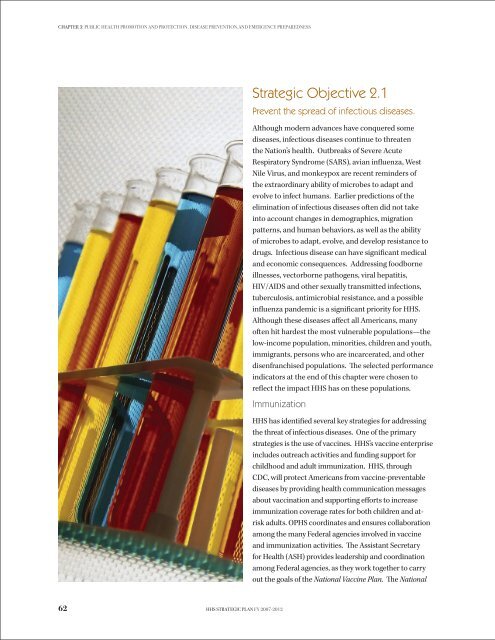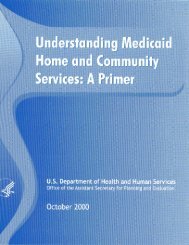CHAPTER 3: Public <strong>Health</strong> Promotion <strong>and</strong> Protection, Disease Prevention,<strong>and</strong> Emergency PreparednessStrategic Objective 2.1Prevent the spread <strong>of</strong> infectious diseases.Although modern advances have conquered somediseases, infectious diseases continue to threatenthe Nation’s health. Outbreaks <strong>of</strong> Severe AcuteRespiratory Syndrome (SARS), avian influenza, WestNile Virus, <strong>and</strong> monkeypox are recent reminders <strong>of</strong>the extraordinary ability <strong>of</strong> microbes to adapt <strong>and</strong>evolve to infect humans. Earlier predictions <strong>of</strong> theelimination <strong>of</strong> infectious diseases <strong>of</strong>ten did not takeinto account changes in demographics, migrationpatterns, <strong>and</strong> human behaviors, as well as the ability<strong>of</strong> microbes to adapt, evolve, <strong>and</strong> develop resistance todrugs. Infectious disease can have significant medical<strong>and</strong> economic consequences. Addressing foodborneillnesses, vectorborne pathogens, viral hepatitis,HIV/AIDS <strong>and</strong> other sexually transmitted infections,tuberculosis, antimicrobial resistance, <strong>and</strong> a possibleinfluenza p<strong>and</strong>emic is a significant priority for HHS.Although these diseases affect all Americans, many<strong>of</strong>ten hit hardest the most vulnerable populations—thelow-income population, minorities, children <strong>and</strong> youth,immigrants, persons who are incarcerated, <strong>and</strong> otherdisenfranchised populations. The selected performanceindicators at the end <strong>of</strong> this chapter were chosen toreflect the impact HHS has on these populations.ImmunizationHHS has identified several key strategies for addressingthe threat <strong>of</strong> infectious diseases. One <strong>of</strong> the primarystrategies is the use <strong>of</strong> vaccines. HHS’s vaccine enterpriseincludes outreach activities <strong>and</strong> funding support forchildhood <strong>and</strong> adult immunization. HHS, throughCDC, will protect Americans from vaccine-preventablediseases by providing health communication messagesabout vaccination <strong>and</strong> supporting efforts to increaseimmunization coverage rates for both children <strong>and</strong> atriskadults. OPHS coordinates <strong>and</strong> ensures collaborationamong the many Federal agencies involved in vaccine<strong>and</strong> immunization activities. The Assistant Secretaryfor <strong>Health</strong> (ASH) provides leadership <strong>and</strong> coordinationamong Federal agencies, as they work together to carryout the goals <strong>of</strong> the National Vaccine Plan. The National62 HHS Strategic Plan FY 2007-2012
CHAPTER 3: Public <strong>Health</strong> Promotion <strong>and</strong> Protection, Disease Prevention,<strong>and</strong> Emergency PreparednessVaccine Plan provides a framework, including goals,objectives, <strong>and</strong> strategies, for pursuing the prevention<strong>of</strong> infectious diseases through immunizations. In 2007–2008, HHS will review <strong>and</strong> revise the existing NationalVaccine Plan to ensure that it addresses new scientific<strong>and</strong> safety issues that have emerged since the first planwas developed. HHS also will continue existing effortsto increase immunization rates for vaccine-preventableillness. Specifically, HHS, through CDC, will develop <strong>and</strong>disseminate health communication messages aboutvaccination <strong>and</strong> support efforts to increase immunizationcoverage rates for both children <strong>and</strong> adults.The Vaccines for Children Program (VFC), whichprovides immunizations for eligible children 6 at theirdoctors’ <strong>of</strong>fices, will continue to be a cornerstone<strong>of</strong> the HHS infectious disease prevention strategy.VFC also helps children whose insurance doesnot cover vaccinations when they receive them atparticipating Federally Qualified <strong>Health</strong> Centers<strong>and</strong> Rural <strong>Health</strong> Clinics. HHS also will work toincrease rates <strong>of</strong> vaccination against influenza <strong>and</strong>pneumococcal viruses through its National Influenza<strong>and</strong> Pneumococcal Vaccination Campaign. This jointinitiative involves CDC, CMS, FDA, HRSA, IHS, <strong>and</strong>NIH along with State <strong>and</strong> local health departments,Medicaid agencies, tribal representatives, healthcare providers, <strong>and</strong> the National Coalition for AdultImmunization. It aims to provide vaccinations forinfluenza <strong>and</strong> pneumonia to beneficiary populations.HIV/AIDSOPHS coordinates all HIV/AIDS-related scientific <strong>and</strong>policy matters, such as new developments <strong>and</strong> programactivities within the areas <strong>of</strong> research, HIV prevention,HIV care <strong>and</strong> treatment, <strong>and</strong> budget development.OPHS also ensures the effective <strong>and</strong> accountablemanagement <strong>of</strong> the <strong>Department</strong>’s HIV/AIDS programs.6 Children 18 years <strong>of</strong> age <strong>and</strong> younger who meet at least one<strong>of</strong> the following criteria are eligible: (1) a child who is eligible forthe Medicaid program; (2) a child who has no health insurancecoverage; (3) American Indian or Alaska Native; (4) a child, if servedby a Federally Qualified <strong>Health</strong> Center or Rural <strong>Health</strong> Clinic, whosehealth insurance benefit plan does not include vaccinations.Building on its existing surveillance, research, <strong>and</strong>screening activities, CDC applies well-integrated,multidisciplinary programs <strong>of</strong> research, surveillance, riskfactor, <strong>and</strong> disease intervention to prevent <strong>and</strong> control thespread <strong>of</strong> HIV infection. For example, CDC is the source<strong>of</strong> national data on the epidemic <strong>and</strong> supports preventionprograms in every State, guided by community planning.These programs reach those at highest risk for acquiringor transmitting infection with effective interventions toreduce their risk <strong>and</strong> protect their health. CDC <strong>and</strong> HRSAwill support efforts to increase knowledge <strong>of</strong> communitycapacity to respond to HIV <strong>and</strong> increase HIV testingstatus, focusing especially on groups <strong>and</strong> communitiesat the highest risk <strong>of</strong> infection. FDA is responsiblefor ensuring the safety <strong>of</strong> the Nation’s blood supply byminimizing the risks <strong>of</strong> infectious disease transmission<strong>and</strong> other hazards while facilitating an adequate supply <strong>of</strong>blood <strong>and</strong> blood products.Routine <strong>and</strong> targeted HIV testing will be key strategiesfor preventing new HIV infections <strong>and</strong> improvingoutcomes for those who test positive. Individualsinfected with HIV who are aware <strong>of</strong> their infection areless likely to engage in risky behaviors <strong>and</strong> are more likelyto take steps to protect their partners. Additionally,individuals infected with HIV who are aware <strong>of</strong> theirinfection can take advantage <strong>of</strong> the therapies that cankeep them healthy <strong>and</strong> extend their lives.Additionally, FDA will continue its work withinternational drug regulatory authorities to promoteexpedited review <strong>of</strong> generic antiretroviral drugs underthe President’s Emergency Plan for AIDS Relief (PEPFAR).HHS, through its operating divisions, especially CDC<strong>and</strong> HRSA, is one <strong>of</strong> the major implementing partnersfor PEPFAR, <strong>and</strong> manages prevention, treatment,<strong>and</strong> care activities in the 15 focus countries <strong>of</strong> theEmergency Plan <strong>and</strong> more than 20 others. HHS alsoprovides part <strong>of</strong> the Federal Government’s financialcontribution to the Global Fund to fight AIDS,tuberculosis, <strong>and</strong> malaria, <strong>and</strong> is part <strong>of</strong> the interagencyteam that guides U.S. policy toward the fund.HHS Strategic Plan FY 2007-201263
















